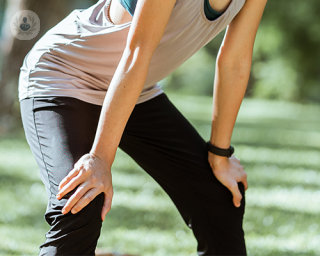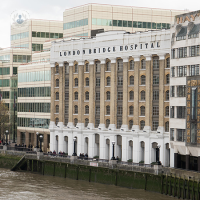Osteoarthritis of the hip
Mr Tom Pollard - Orthopaedic surgery
Created on: 11-13-2012
Updated on: 11-09-2023
Edited by: Karolyn Judge
What is hip osteoarthritis?
Hip osteoarthritis is a degenerative disease of the cartilage that covers the joint of the pelvic and femoral bones. This tissue facilitates movement between the bones and prevents them from rubbing against each other directly. When the cartilage decreases in thickness and texture, or is lost completely, the mechanism between the femur and the pelvis no longer functions correctly, resulting in hip osteoarthritis. It can vary in severity, from mild to severe.

What is the outlook for osteoarthritis?
Hip osteoarthritis is a chronic disease and usually progresses slowly over many years. It is one of the most common types of osteoarthritis.
What are the symptoms of hip osteoarthritis?
The main indicator of this condition is pain, which is primarily located in the groin area. Symptoms such as stiffness and impaired functionality (mobility) may also be present. The pain may sometimes radiate down the front of the thigh and also affect the knees, which might lead you to think that the problem is with the knee.
What are the medical tests for hip osteoarthritis?
In order to diagnose hip osteoarthritis, the specialist will:
- Ask questions about your symptoms and ask you to describe them.
- Examine the hip joint and its movements. This enables the specialist to assess the degree of osteoarthritis.
- X-ray the hip, to confirm the diagnosis.
- MRI scans may also be used.
What causes hip osteoarthritis?
The causes of hip osteoarthritis are numerous and results from a combination of genetic and environmental factors.
Some of the secondary factors that cause hip osteoarthritis, either combined or in isolation, are:
- Obesity
- Older age
- Professional activity
- Excessive strain on the joint due to high-intensity sport
- Malformations
Can hip osteoarthritis be prevented?
One of the causes for the onset of hip osteoarthritis is ageing, making it impossible to avoid the disease. However, onset of the disease can be significantly delayed.
The main actions you can take to try to prevent hip osteoarthritis are to:
- Lose weight
- Do physical exercise. This includes exercising the hip joints.
- Avoid movements that cause pain
- Use canes or crutches
- Follow a good diet
How is hip osteoarthritis treated?
There is currently no treatment that can cure hip osteoarthritis, but it can relieve symptoms, slow the progression of the disease and improve quality of life. There are several alternatives available:
- Weight control
- Correction of anatomical malformations or alterations
- Physical exercise
- Medication
- Surgery: replacement of the joint with an implant. This is usually performed for severe cases of the disease.
Physical measures and medication can be considered conservative treatments, the aim of which is to minimise pain and immobilisation and to slow down the progression of the disease as much as possible.
Which specialist treats hip osteoarthritis?
Rheumatologists and orthopaedic surgeons would diagnose and treat hip osteoarthritis.
















